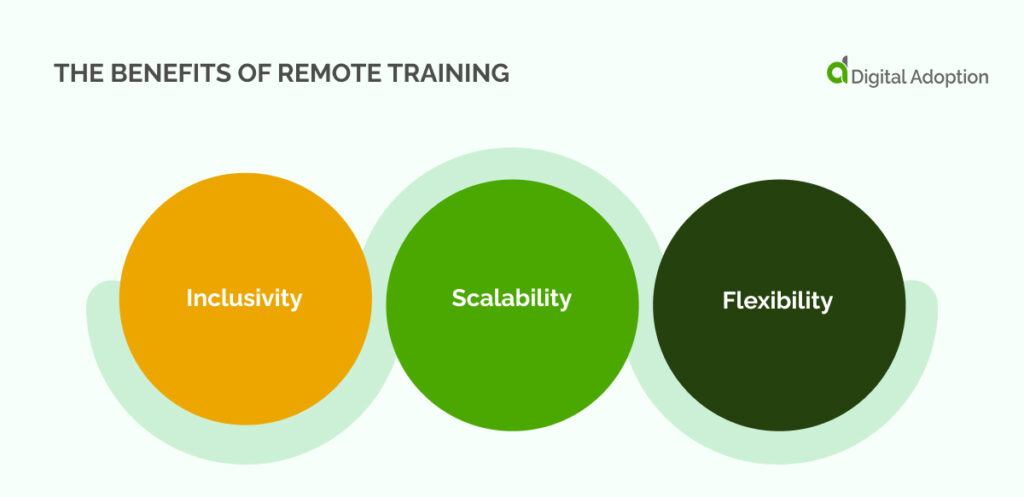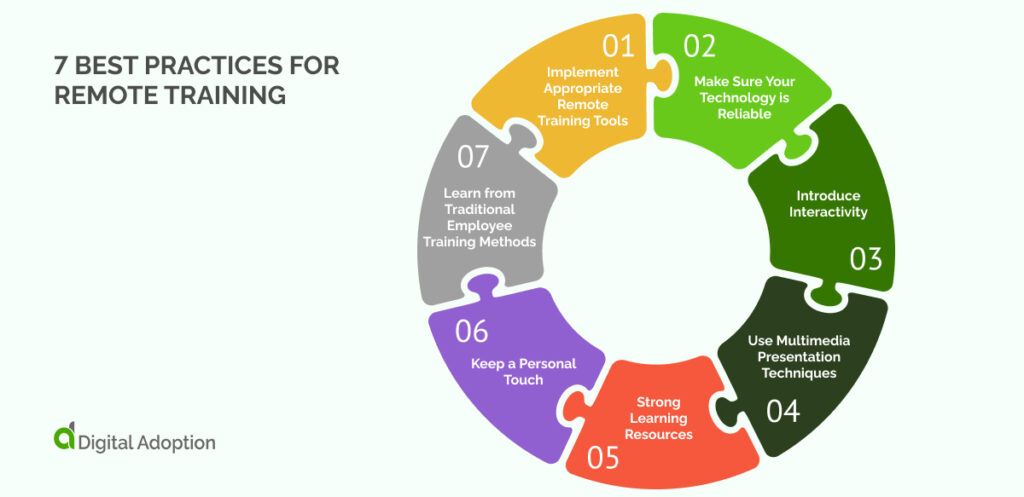If you’re formulating a future of work strategy, you’ll know that you need to pay attention to upskilling, reskilling, and all other learning and development tasks. In 2024, you’ll need to make sure your staff have got the skills they need to do their jobs effectively. Whether they are working in person, at home, or fully remotely, they must come along for the journey.
To cover all of these eventualities, remote training offers you one of the best possible methods of delivering instruction to large groups of people. In this guide, we’ll go over the key features of remote learning that you need to know about. We will:
- Explain what remote learning is
- Introduce the core benefits of remote training
- Give you seven best practices that will make your remote training programs effective.
By the end, you should have everything you need to know to get remote training up and running in your organization.
What is Remote Training?
Remote training refers to any form of training conducted without the necessity for physical presence. This training methodology can take various forms, including synchronous sessions with real-time interaction, asynchronous modules that participants can access at their convenience, or self-paced learning opportunities. The common feature is that participants can engage from disparate locations.
The significance of remote training methods has been underscored by the global shift towards online work and learning, especially in the wake of the pandemic. It remains relevant in 2024, although many offices are returning to in-person work. Even when training could be completed in person, remote training still gives valuable support to organizations (as we will see in the following section).
Remote training often uses one of a dedicated suite of digital tools. Commonly employed platforms such as Zoom, Teams, Slack, or Learning Management Systems (LMS) play a pivotal role in ensuring the efficiency and accessibility of the training process.
The Benefits of Remote Training

In this section, we’ll introduce three important factors: inclusivity, scalability, and efficiency.
Inclusivity
Many disabilities can make it difficult for people to attend in-person training sessions. However, with remote employee training, geographical barriers and physical constraints become less relevant. Moreover, the ease of recording and sharing training sessions ensures that those unable to be present on a specific day can still benefit.
In short, remote training strives to make learning opportunities accessible to everyone, fostering a more inclusive and diverse learning environment.
Scalability
Business organizations allocate substantial budgets to training, and these costs have historically limited the number of employees who can participate. However, remote training offers a solution to scalability challenges. The online nature of remote training makes it considerably more scalable, allowing organizations to deliver training to a larger audience without a proportionate increase in costs.
While there are still expenses involved, such as trainers and the Learning Management System, the ability to reach a broader audience makes remote training a more cost-effective and scalable solution for workforce development.
Flexibility
Flexibility is a key advantage of remote training, accommodating the diverse schedules and commitments of individuals. Unlike traditional training that may require participants to be present on a specific day and at a designated location, remote training offers the freedom to fit learning into people’s busy lives.
Whether individuals are traveling, juggling other work commitments, or adhering to specific schedules, remote training allows them to access learning materials at their convenience. This flexibility not only enhances the learning experience but also promotes a more adaptive and personalized approach to skill development.
7 Best Practices for Remote Training

To achieve the benefits of remote training, you’ve got to go through a lot of careful planning, preparation, and execution. Fortunately, there are some tried-and-tested methods that will help you achieve the best out of online training courses. To help, in this section, we’ll look at the seven best practices of training remote employees.
Along the way, you might notice that some of the training “dos and don’ts” are rooted in good old-fashioned teaching skills. If you’re a successful trainer, you’ll be in a great position to pick up these remote training strategies and make them work for you.
- Implement Appropriate Remote Training Tools
To get started with remote training, make sure you introduce suitable technologies such as adaptive learning platforms, communication tools, learning management systems (LMS), and digital adoption platforms.
Utilizing these tools allows for a more dynamic and efficient training experience. Adaptive learning platforms cater to individual needs, communication tools foster interaction, LMS streamlines content delivery, and digital adoption platforms ensure seamless integration of new technologies.
While implementing these technologies may require some initial setup, the long-term benefits in terms of engagement and effectiveness make it a worthwhile investment for remote training programs.
- Make Sure Your Technology is Reliable
Maybe it goes without saying. But if you want a successful remote training program, you’ve got to prioritize the reliability of your technology stack. This involves rigorous testing, robust technical support, and careful software selection. With the right steps, you can expect that the platforms will operate smoothly, suffer few disruptions, and any problems are quickly resolved.
Reliability will demand considerable initial effort and investment. However, there is a major payoff in terms of consistent and dependable remote training experiences. Technical problems can be a stumbling block that some employees won’t get over on their own.
- Introduce Interactivity
If remote learning doesn’t ask for learners to do anything, it will be boring and ineffective. Fortunately, you can enhance the effectiveness of remote training by introducing interactivity.
That may include incorporating elements such as gamification, testing, and feedback into the learning experience. Interactive training is more engaging and reinforces knowledge retention. Participants actively involved in their learning process are likely to have a deeper understanding of the material.
Using interactivity requires some creativity and planning, the positive impact on participant engagement and the overall effectiveness of remote training makes it an easily achievable and beneficial strategy.
- Use Multimedia Presentation Techniques
Flexibility is one of the major advantages of online learning techniques.
Take advantage of the situation by presenting your training material through a wide range of media formats. Integrating various learning materials such as slides, quizzes, videos, and text into one platform enriches the learning experience. This approach caters to diverse learning styles and preferences.
The ease of combining different types of content makes remote training more versatile and engaging. Achieving this multimedia approach is straightforward, as modern technology and learning platforms readily support diverse content formats. Let your imagination run wild!
- Strong Learning Resources
Even in the online realm, the foundation of effective training lies in strong learning resources. Flashy presentations and digital platforms won’t suffice if the content is not thorough and excellent. Invest time and effort in developing comprehensive training materials. Ensure that the content is clear, relevant, and aligned with the learning objectives. While creating strong learning resources demands attention to detail and careful planning, neglecting this aspect risks undermining the entire training process.
- Keep a Personal Touch
One of the major downsides of remote learning is that it may be less friendly than some other methods.
Mitigate the potential impersonality of remote learning by maintaining a personal touch. Implement regular check-ins, peer support systems, or forums to keep learners connected and engaged. These practices foster a sense of community and provide avenues for participants to ask questions and share insights.
- Learn from Traditional Employee Training Methods
Finally – let’s remember that remote training is based on traditional learning and development methods. Many of the principles that work effectively in a classroom, tutorial, or coaching situations, will similarly work when you’re designing an online course.
For example, you can think about:
- Clear learning objectives
- Excellent communications
- Appropriate pacing
- Intelligent sequencing
- Meaningful feedback
- Differentiation and personalization
Leveraging these tried-and-tested principles from traditional methods contributes to the success of remote training. Integrating them into digital formats is a simple but reliable way to optimize the learning process.
Activate your Remote Employees with Remote Training
If you haven’t already got a good remote training program, 2024 should be the year that you make it happen. The impact of online courses on leaders and workers alike is potentially huge.
From a CEO’s point of view, there’s an ongoing problem with a “skills gap,” as a 2021 McKinsey report explains. Producing a lot of high-quality online training materials means that the skills gap will be a little bit easier to close.
And from an individual wellbeing point of view, remote workers need support with job manageability as much as possible. Effective remote training can be one of the simplest ways to get there.













